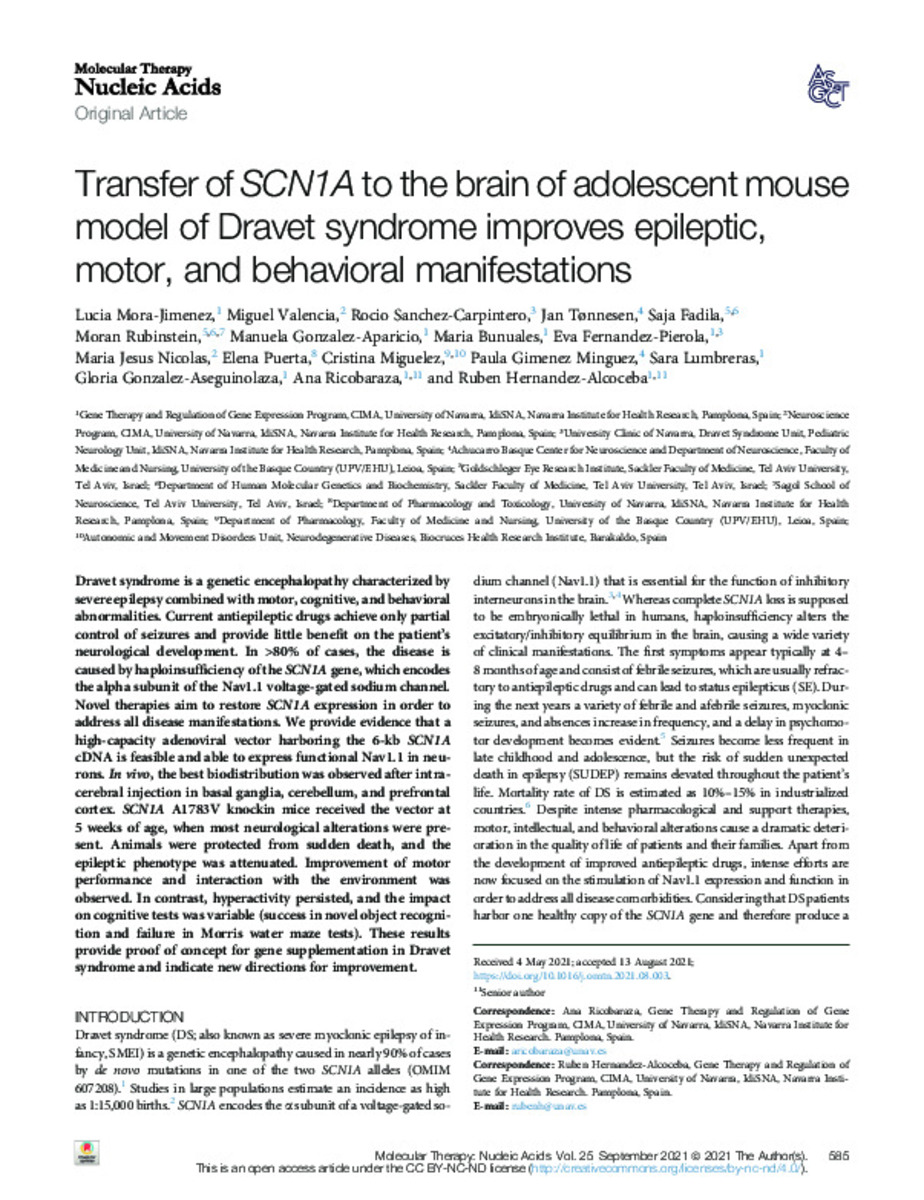Full metadata record
| DC Field | Value | Language |
|---|---|---|
| dc.creator | Mora-Jiménez, L. (Lucía) | - |
| dc.creator | Valencia, M. (Miguel) | - |
| dc.creator | Sanchez-Carpintero, R. (Rocío) | - |
| dc.creator | Tønnesen, J. (Jan) | - |
| dc.creator | Fadila, S. (Saja) | - |
| dc.creator | Rubinstein, M. (Moran) | - |
| dc.creator | Gonzalez-Aparicio, M. (Manuela) | - |
| dc.creator | Buñuales, M. (María) | - |
| dc.creator | Fernandez-Pierola, E. (Eva) | - |
| dc.creator | Nicolas, M.J. (María Jesús) | - |
| dc.creator | Puerta, E. (Elena) | - |
| dc.creator | Miguelez, C. (Cristina) | - |
| dc.creator | Gimenez-Minguez, P. (Paula) | - |
| dc.creator | Lumbreras, S. (Sara) | - |
| dc.creator | González-Aseguinolaza, G. (Gloria) | - |
| dc.creator | Ricobaraza, A. (Ana) | - |
| dc.creator | Hernandez-Alcoceba, R. (Rubén) | - |
| dc.date.accessioned | 2022-04-06T12:39:43Z | - |
| dc.date.available | 2022-04-06T12:39:43Z | - |
| dc.date.issued | 2021 | - |
| dc.identifier.citation | Mora-Jiménez, L. (Lucía); Valencia, M. (Miguel); Sanchez-Carpintero, R. (Rocío); et al. "Transfer of SCN1A to the brain of adolescent mouse model of Dravet syndrome improves epileptic, motor, and behavioral manifestations". Molecular Therapy - Nucleic Acids. 25, 2021, 585 - 602 | es_ES |
| dc.identifier.issn | 2162-2531 | - |
| dc.identifier.uri | https://hdl.handle.net/10171/63364 | - |
| dc.description.abstract | Dravet syndrome is a genetic encephalopathy characterized by severe epilepsy combined with motor, cognitive, and behavioral abnormalities. Current antiepileptic drugs achieve only partial control of seizures and provide little benefit on the patient’s neurological development. In >80% of cases, the disease is caused by haploinsufficiency of the SCN1A gene, which encodes the alpha subunit of the Nav1.1 voltage-gated sodium channel. Novel therapies aim to restore SCN1A expression in order to address all disease manifestations. We provide evidence that a high-capacity adenoviral vector harboring the 6-kb SCN1A cDNA is feasible and able to express functional Nav1.1 in neurons. In vivo, the best biodistribution was observed after intracerebral injection in basal ganglia, cerebellum, and prefrontal cortex. SCN1A A1783V knockin mice received the vector at 5 weeks of age, when most neurological alterations were present. Animals were protected from sudden death, and the epileptic phenotype was attenuated. Improvement of motor performance and interaction with the environment was observed. In contrast, hyperactivity persisted, and the impact on cognitive tests was variable (success in novel object recognition and failure in Morris water maze tests). These results provide proof of concept for gene supplementation in Dravet syndrome and indicate new directions for improvement. | es_ES |
| dc.description.sponsorship | This research was funded by projects RTI2018-097730-B-I00/MCI/AEI/FEDER, ERA-NeT E-Rare, AC17/00029 (ISCIII)/FEDER, and Inocente-inocente Foundation. L.M.-J. is a recipient of a Pedro Lopez Berastegui fellowship | es_ES |
| dc.language.iso | eng | es_ES |
| dc.publisher | Elsevier | es_ES |
| dc.rights | info:eu-repo/semantics/openAccess | es_ES |
| dc.subject | SCN1A | es_ES |
| dc.subject | Nav1.1. | es_ES |
| dc.subject | Dravet syndrome | es_ES |
| dc.subject | Epilepsy | es_ES |
| dc.subject | Encephalopathy | es_ES |
| dc.subject | Adenovirus | es_ES |
| dc.subject | Gene therapy | es_ES |
| dc.title | Transfer of SCN1A to the brain of adolescent mouse model of Dravet syndrome improves epileptic, motor, and behavioral manifestations | es_ES |
| dc.type | info:eu-repo/semantics/article | es_ES |
| dc.description.note | This is an open access article under the CC BY-NC-ND license | es_ES |
| dc.identifier.doi | 10.1016/j.omtn.2021.08.003 | - |
| dadun.citation.endingPage | 602 | es_ES |
| dadun.citation.publicationName | Molecular Therapy - Nucleic Acids | es_ES |
| dadun.citation.startingPage | 585 | es_ES |
| dadun.citation.volume | 25 | es_ES |
Files in This Item:
Statistics and impact
Items in Dadun are protected by copyright, with all rights reserved, unless otherwise indicated.






